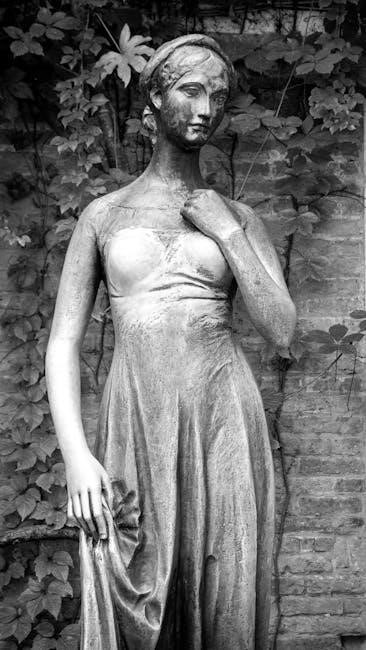
Set in Verona, Romeo and Juliet explores the tragic love between two teens from feuding families, leading to heart-wrenching consequences. A timeless tale of love and loss, the play is widely studied, with numerous PDF summaries and study guides available for deeper analysis.

Overview of the Play
Romeo and Juliet, a tragic play by William Shakespeare, is set in Verona, where two noble families, the Montagues and Capulets, harbor a deep-seated feud. Against this backdrop of hatred, Romeo, a Montague, and Juliet, a Capulet, fall deeply in love at a ball. They marry in secret with the help of Friar Lawrence, hoping to end the conflict. However, when Tybalt kills Romeo’s friend Mercutio, Romeo avenges his death, leading to his banishment. Juliet fakes her death to avoid another marriage, but Romeo believes she is truly dead and poisons himself. Juliet awakens to find Romeo dead and stabs herself with his dagger. Their tragic end ultimately unites the families, highlighting the devastating cost of blind hatred and impulsive actions. The play remains a timeless exploration of love, fate, and conflict, with numerous PDF summaries and study guides available for deeper understanding.
Historical Context
Set in Verona, Italy, Romeo and Juliet is rooted in a historical feud between two powerful families, the Montagues and Capulets. The play, written around 1595-1597, reflects the societal norms of Renaissance Italy, where family loyalty and honor were paramount. The ongoing rivalry between the families is fueled by a long-standing vendetta, with public brawls and the Prince of Verona’s threats of death for further violence. The historical context highlights the rigid social structure and the devastating consequences of unchecked hatred. Shakespeare’s adaptation of an older Italian tale emphasizes the timeless relevance of its themes. PDF summaries often explore this historical backdrop, providing insight into the play’s enduring appeal and tragic outcomes.
Significance of the Tragic Love Story
The tragic love story of Romeo and Juliet transcends time, symbolizing the destructive power of hate and the redemptive force of love. Their tale serves as a universal cautionary narrative, highlighting the devastating consequences of impulsive actions and unresolved feuds. The play’s enduring significance lies in its exploration of human emotions, making it a cornerstone of literature and art. PDF summaries often emphasize how the story underscores the importance of understanding and reconciliation, offering timeless moral lessons. Its impact resonates across cultures, inspiring countless adaptations and interpretations, ensuring its relevance for future generations.
Plot Summary of Romeo and Juliet
Set in Verona, Romeo and Juliet follows star-crossed lovers from feuding families. Their secret marriage, Tybalt’s vengeance, and Juliet’s fake death lead to tragic consequences.
In Verona, the longstanding feud between the Montagues and Capulets sets the stage for tragedy. The play opens with a brawl between their servants, halted by Prince Escalus, who warns of severe punishment for further violence. The Montagues, including Romeo, are introduced, while the Capulets, with Juliet, are preparing for a ball. Lord Capulet arranges Juliet’s marriage to Paris, unaware of her reluctance. Romeo, infatuated with Rosaline, attends the ball, where he meets Juliet, sparking an instant connection. Key characters like Tybalt, Juliet’s cousin, and Friar Lawrence, a wise mentor, are introduced, foreshadowing the conflict and romance that will unfold.
Act 2: The Secret Marriage
Romeo and Juliet’s love blossoms at the Capulet ball, leading to a secret marriage with Friar Lawrence officiating. Hoping to end the feud, Friar Lawrence agrees to unite them. Juliet’s parents, unaware of her marriage, arrange her engagement to Paris, causing Juliet to refuse, sparking family conflict. This act highlights the intensity of their love and the risks they take, setting the stage for future tragic events.
Act 3: The Tragic Confrontation
Tybalt, Juliet’s cousin, seeks revenge against Romeo for attending the Capulet ball. He kills Mercutio, Romeo’s friend, in a duel. Enraged, Romeo slays Tybalt and is banished from Verona. Meanwhile, Juliet’s parents arrange her marriage to Paris, unaware of her secret union with Romeo. This act escalates the conflict, deepening the tragic fate of the lovers; The consequences of impulsive actions and the unrelenting feud between the families intensify the emotional turmoil, setting the stage for the heartbreaking events that follow.
Act 4: The Hasty Decisions
Juliet, desperate to avoid marrying Paris, turns to Friar Lawrence, who devises a risky plan. He gives her a potion to feign death, hoping to reunite her with Romeo. Juliet consumes it, and her family, believing she is dead, buries her. Meanwhile, Romeo, unaware of the plan, hears of Juliet’s death and poisons himself in her tomb. Juliet awakens to find Romeo dead and, in grief, stabs herself with his dagger. This act highlights the tragic consequences of impulsive decisions and the devastating impact of miscommunication, leading to the ultimate sacrifice of the star-crossed lovers.
Act 5: The Ultimate Sacrifice
In the final act, Romeo, believing Juliet is dead, poisons himself in her tomb. Juliet awakens to find Romeo dead and, overwhelmed by grief, stabs herself with his dagger. The tragic end of the lovers ultimately brings peace between their families, as they realize the senseless destruction their feud has caused. This act underscores the devastating consequences of impulsive actions and the redemptive power of love, leaving a lasting impact on the audience. The sacrifice of the star-crossed lovers becomes a symbol of the futility of hatred and the enduring power of true love.

Main Characters in Romeo and Juliet
The play centers around Romeo Montague, a passionate lover, and Juliet Capulet, his determined bride, whose families’ feud seals their fate. Tybalt, Juliet’s vengeful cousin, and Friar Lawrence, the well-meaning mentor, drive the tragic events, highlighting the destructive power of hate and impulsive decisions.
Romeo Montague: The Impulsive Lover
Romeo, a Montague, is a passionate and emotional young man driven by his heart. His impulsive nature leads him to fall in and out of love quickly, as seen with Rosaline and Juliet. His love for Juliet is intense, prompting him to marry her in secret. When his friend Mercutio is killed by Tybalt, Romeo’s impulsiveness results in tragic consequences, including Tybalt’s death and his own banishment. His rash decisions, such as sneaking into the Capulet tomb, ultimately seal his fate. Romeo’s emotional journey highlights the destructive power of unchecked passion and haste, making him a central figure in the play’s tragic unfolding.
Juliet Capulet: The Determined Bride
Juliet, a Capulet, evolves from a naive girl to a determined woman. Initially obedient, she defies her family by marrying Romeo in secret, showcasing her growing independence. Her determination is evident when she refuses to marry Paris, even facing her parents’ anger. Juliet’s resolve strengthens as she devises a plan to reunite with Romeo, willing to risk death by faking her own death. Her ultimate sacrifice, killing herself to avoid leaving Romeo, underscores her unwavering commitment to their love. Juliet’s transformation from innocence to determination makes her a powerful and tragic figure, embodying the play’s themes of love and sacrifice.
Tybalt: The Vengeful Cousin
Tybalt, Juliet’s cousin, is a fiery and vengeful character driven by hatred for the Montagues. His animosity toward Romeo escalates tensions, leading to Mercutio’s death and Romeo’s banishment. Tybalt’s impulsive nature and desire for revenge dominate his actions, making him a catalyst for tragedy. His death at Romeo’s hands intensifies the families’ feud and seals the lovers’ fate. Tybalt’s role highlights the destructive power of hatred and the inevitability of the play’s tragic conclusion, showcasing Shakespeare’s exploration of unchecked emotions and their devastating consequences.
Friar Lawrence: The Well-Meaning Mentor
Friar Lawrence, a wise and compassionate Franciscan friar, serves as a mentor to both Romeo and Juliet. He believes their union can end the feud between their families and agrees to marry them in secret. His well-intentioned plan involves giving Juliet a potion to feign death, hoping it will reunite the lovers. However, his scheme unravels tragically when the message about the plan fails to reach Romeo. Despite his good intentions, Friar Lawrence’s actions inadvertently contribute to the play’s devastating conclusion. His role underscores the complexities of fate and the unintended consequences of even the most noble efforts.

Themes in Romeo and Juliet
The play explores themes of love vs. hate, fate, and impulsiveness, highlighting how family feuds and rash decisions lead to tragic, devastating consequences.
Love vs. Hate: The Central Conflict
The central conflict in Romeo and Juliet revolves around the intense struggle between love and hate. The profound love between Romeo and Juliet contrasts sharply with the deep-seated hatred between their families, the Montagues and Capulets. This conflict drives the plot, as their love blossoms in secret amidst the animosity, leading to tragic consequences. The play highlights how hate can destroy even the purest forms of love, ultimately resulting in devastating loss. This theme remains timeless, emphasizing the destructive power of hatred and the redemptive potential of love, even in the face of inevitable tragedy.
Fate and Destiny: The Inevitable Tragedy
The tragic ending of Romeo and Juliet is deeply rooted in fate and destiny, as the characters are trapped in a cycle of events beyond their control. From the moment they meet, their love is doomed by the feud between their families. The play suggests that fate orchestrates their downfall, with pivotal moments like the apothecary’s poison and the delayed letter sealing their destiny. Shakespeare emphasizes the inevitability of tragedy, highlighting the clash between free will and fate. The characters’ impulsive decisions, driven by love and hatred, ultimately lead to their demise, illustrating the destructive power of fate and the futility of resisting it.
Impulsiveness and Rash Decisions
Impulsiveness and rash decisions are central to the tragic outcome of Romeo and Juliet. Romeo’s hasty marriage to Juliet and his impulsive killing of Tybalt exemplify his reckless behavior, driven by emotion rather than reason. Similarly, Juliet’s decision to fake her death to avoid marrying Paris, while desperate, accelerates the play’s tragic conclusion. These impulsive actions, often made in the heat of the moment, highlight the destructive consequences of acting without foresight. Shakespeare uses these decisions to illustrate how impulsive behavior can lead to devastating results, underscoring the theme of rashness as a catalyst for tragedy in the play.

Historical and Cultural Context
Set in Verona, Romeo and Juliet reflects the city’s historical rivalry between noble families. The feud-driven society, governed by strict codes of honor and loyalty, is central to the tragedy. The Prince’s authority and the societal norms of arranged marriages and family loyalty shape the characters’ actions, highlighting the cultural tensions of Renaissance Italy.
Verona: The Setting of the Play
Verona, a city in northern Italy, serves as the backdrop for Romeo and Juliet. Its rich history and cultural significance create a vivid setting for the tragic events. The city’s architecture, with its ancient streets and grand houses, reflects the wealth and prestige of the feuding families. Verona’s public spaces, like the town square, become stages for conflict and drama. The Prince of Verona’s authority adds a layer of political tension, as he struggles to maintain order amidst the families’ rivalry. The setting’s beauty contrasts sharply with the violence and tragedy, emphasizing the destructive nature of the feud. Verona’s cultural and historical context shapes the characters’ identities and the play’s themes of love, loyalty, and fate.
The Feud Between Montagues and Capulets
The bitter rivalry between the Montagues and Capulets drives the tragic events of Romeo and Juliet. Originating from a long-standing grudge, the feud escalates into violent clashes, drawing in servants, family members, and even the Prince of Verona. The families’ hatred is so intense that it overshadows reason, leading to impulsive actions and devastating consequences. The feud not only divides Verona but also isolates the lovers, forcing them to keep their relationship secret. This endless cycle of vengeance and retaliation ultimately leads to the loss of the two young lovers, highlighting the destructive power of unchecked hatred and the futility of prolonged conflict.

Literary Devices in Romeo and Juliet
Shakespeare employs metaphors, similes, and symbolism to enrich the play’s emotional depth. These devices highlight the tragic tone and underscore themes of love, fate, and conflict, enhancing the narrative’s impact.
Use of Metaphors and Similes
Shakespeare’s masterful use of metaphors and similes in Romeo and Juliet creates vivid imagery, enhancing emotional depth. For instance, Romeo compares Juliet to the sun, emphasizing her radiant beauty. Similarly, Juliet likens their love to a rose, symbolizing its beauty and thorns. These literary devices not only enrich the dialogue but also deepen the audience’s connection to the characters’ emotions. Metaphors like “love is a smoke” and similes such as “soft as a maiden’s voice” illustrate the complexity of their feelings, making the play’s themes of love and tragedy universally relatable and enduring.
Symbolism in the Play
Symbolism plays a crucial role in Romeo and Juliet, enriching the narrative with deeper meanings. The rose symbolizes love’s beauty and danger, as Romeo and Juliet’s families bear names tied to flowers. Light and darkness represent emotional states: Juliet is often linked to light, while darkness signifies conflict and death. The apothecary’s poison symbolizes the destructive power of the feud. These symbols enhance the tragic atmosphere, highlighting themes of love, fate, and mortality. Shakespeare’s use of symbolism allows audiences to connect with the universal emotions of the story, making it timeless and relatable across generations.
Character Analysis
Romeo and Juliet are symbols of young love, impulsiveness, and tragic fate. Their personalities drive the story, with Romeo’s passion and Juliet’s determination leading to devastating consequences.
The Psychological Development of Romeo
Romeo’s psychological journey is marked by impulsiveness and emotional depth. Initially, he appears as a lovesick teenager, infatuated with Rosaline. However, upon meeting Juliet, his passion deepens, showcasing his capacity for genuine love. His impulsive nature leads to rash decisions, such as secretly marrying Juliet and killing Tybalt, highlighting his struggle with self-control. Throughout the play, Romeo evolves from a romantic idealist to a tragic figure, driven by desperation and fate. His ultimate decision to end his life demonstrates the devastating impact of his emotional turmoil and the inevitability of his doomed fate.
The Transformation of Juliet
Juliet undergoes a profound transformation from a naive, obedient daughter to a determined, independent individual. Initially, she adheres to her parents’ wishes, reflecting societal expectations. However, upon meeting Romeo, she embraces her emotions and defies tradition by secretly marrying him. Her decision to fake her death to avoid another marriage showcases her growing assertiveness and willingness to take control of her destiny. Despite her youth, Juliet demonstrates remarkable resilience and maturity, ultimately sacrificing her life for love. This transformation highlights her evolution from a passive figure to a strong-willed individual, making her one of Shakespeare’s most compelling female characters.
Tragic Elements in the Play
The feud between families, impulsive decisions, and unavoidable fate create a devastating tragedy, highlighting the destructive power of hate and the irreversible consequences of rash actions.
The Role of Fate
Fate plays a central role in Romeo and Juliet, as the characters’ lives are shaped by forces beyond their control. From their initial meeting to the tragic conclusion, fate drives the narrative. The feud between families, the timing of key events, and the ultimate sacrifice of the lovers underscore the inevitability of their destiny. Shakespeare portrays fate as an unyielding force, leaving the characters with little agency. This theme is reinforced by the chorus’s commentary, which frames the story as a tale of star-crossed lovers doomed from the start. Fate’s role emphasizes the tragic nature of the play, highlighting the helplessness of the characters against their predetermined outcomes.
The Impact of Impulsive Actions
Impulsive actions drive the tragic progression of Romeo and Juliet. Romeo’s hasty decision to kill Tybalt after Mercutio’s death leads to his banishment, escalating the conflict. Similarly, Juliet’s impulsive choice to fake her death to avoid marrying Paris ultimately seals her fate. The rushed marriage and secret plans highlight the characters’ lack of foresight, leading to devastating consequences. These impulsive decisions underscore the destructive nature of acting without consideration, propelling the story toward its tragic conclusion. Shakespeare uses these moments to illustrate how rash behavior, combined with fate, can lead to irreversible and heart-wrenching outcomes, emphasizing the play’s central themes of impulsivity and its dire repercussions.

Moral and Ethical Lessons
The play teaches the consequences of blind hatred and impulsive actions, emphasizing the importance of forgiveness and understanding to break cycles of violence and revenge.
Consequences of Blind Hatred
Blind hatred fuels the relentless feud between the Montagues and Capulets, leading to devastating consequences. The families’ inability to forgive escalates violence, resulting in the deaths of Mercutio, Tybalt, and ultimately Romeo and Juliet. Their tragic fate underscores the destructive power of unchecked animosity. The play highlights how pride and vengeance blind individuals to reason, causing irreparable harm. Shakespeare illustrates that when hatred dominates, it consumes not only the haters but also the innocent, leaving behind a legacy of sorrow. The senseless loss of young lives serves as a poignant reminder of the importance of breaking cycles of hatred and embracing reconciliation.

Adaptations and Interpretations
Romeo and Juliet has inspired countless adaptations, from modern retellings to cinematic interpretations, ensuring its timeless story remains relevant across generations and cultures, captivating new audiences continually.
Modern Retellings of the Story
Modern retellings of Romeo and Juliet creatively reinterpret the classic tale for contemporary audiences. Adaptations like West Side Story and Romeo + Juliet (1996) reimagine the story in new settings, such as urban neighborhoods or high schools, while maintaining the core themes of love and conflict. Recent films and TV shows continue to explore the story through diverse lenses, incorporating modern cultural elements and issues. These interpretations highlight the timeless relevance of Shakespeare’s work, appealing to younger generations and showcasing the universality of the tragic love story. By blending traditional themes with modern contexts, these retellings ensure the story’s enduring appeal.
Cinematic Versions of Romeo and Juliet
Cinematic adaptations of Romeo and Juliet have captivated audiences for decades, offering fresh interpretations of Shakespeare’s timeless tale. Franco Zeffirelli’s 1968 film remains a classic, blending traditional dialogue with stunning visuals. Baz Luhrmann’s 1996 version reimagines the story in a modern setting, featuring a star-studded cast and vibrant visuals. Both films stay true to the original’s emotional depth while appealing to different eras. These adaptations highlight the story’s universal themes, proving its enduring relevance. By bringing the play to life on screen, they introduce the tragic love story to new generations, ensuring its legacy endures in popular culture.

Study Guides and Resources
Downloadable PDF summaries and study guides provide in-depth analysis of Romeo and Juliet, including plot overviews, character insights, and thematic discussions. Online resources offer additional study support.
PDF Summaries and Study Materials
Various online platforms offer PDF summaries of Romeo and Juliet, providing detailed overviews of the play’s plot, characters, and themes. These resources are ideal for quick reference or study. SparkNotes and Scribd offer comprehensive guides, including scene-by-scene breakdowns, character analyses, and thematic insights. Many PDFs are free to download and printable, making them convenient for students. They often include key quotes, study questions, and context about Shakespeare’s historical background. These materials are invaluable for understanding the play’s structure and preparing for exams or discussions. They cater to both students and educators, offering a concise yet thorough exploration of the tragic love story.

Online Resources for Further Study
For deeper exploration of Romeo and Juliet, numerous online resources are available. Websites like SparkNotes and Scribd offer detailed study guides, scene analyses, and thematic breakdowns. YouTube channels provide video summaries and character studies, while educational platforms like Khan Academy and Crash Course offer insightful lectures. Additionally, many universities and literary websites publish articles on the play’s historical context and literary devices. These resources are invaluable for students seeking to enhance their understanding of the play’s complexities. They also include interactive quizzes, discussion forums, and downloadable materials, making them accessible and engaging for learners of all levels.
Romeo and Juliet remains a timeless tale of tragic love, exploring themes of fate, impulsive decisions, and the devastating consequences of unchecked hatred. The play’s enduring popularity lies in its universal themes and relatable characters, offering lessons on love, family, and reconciliation. Through its tragic ending, Shakespeare underscores the futility of prolonged feuds and the redemptive power of sacrifice. The story continues to resonate, inspiring countless adaptations and interpretations. As a cautionary tale, it reminds us of the importance of understanding and forgiveness, ensuring its relevance for generations to come. The play’s legacy endures, a poignant reminder of love’s transformative yet fragile nature.